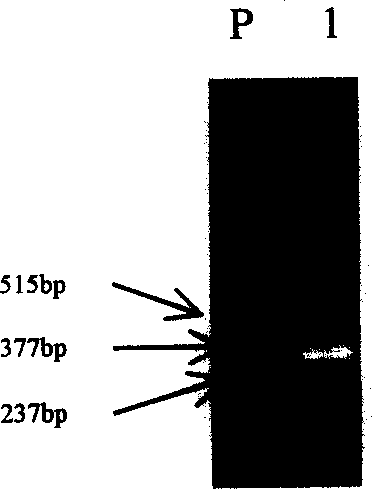Gene engineering method for raising plant useful secondary substance content
A secondary substance and useful technology, applied in the direction of plant genetic improvement, botanical equipment and methods, using micro-injection method, etc., can solve the problem of lignin content that has not been seen, and achieve the effect of increasing content and increasing yield
- Summary
- Abstract
- Description
- Claims
- Application Information
AI Technical Summary
Problems solved by technology
Method used
Image
Examples
Embodiment 1
[0042] Example 1. Cloning of lignin synthesis key enzyme gene CCR and construction of its antisense expression vector
[0043] 1) Plant material: The tested Arabidopsis thaliana L. Heynh was Columbia ecotype, donated by Mr. Xu Zhengwei, Institute of Plant Physiology and Ecology, Chinese Academy of Sciences. Genomic DNA of Arabidopsis thaliana was extracted from leaves by CTAB method.
[0044] 2) Strains and plasmids: The cloning vector pUCm-T vector is a product of Bocai Biotechnology Co., Ltd. Plant expression binary vector pIG121, helper plasmid pRK2013, Escherichia coli DH5α, HB101, Agrobacterium tumefacious EHA105 were preserved by the Crop Quality Improvement Genetic Engineering Laboratory of Zhejiang Academy of Agricultural Sciences.
[0045] 3) Enzymes and chemical reagents: restriction endonuclease, T4 DNA ligase, calf intestinal alkaline phosphatase (CIAP) and other tool enzymes, λDNA / HindIII were purchased from MBI Company, DNA molecular weight marker PCR Marker was...
Embodiment 2
[0065] Example 2. Transformation of Arabidopsis thaliana with antisense CCR gene
[0066] 1) Arabidopsis transformation
[0067] Use the inflorescence spray method. Select plump Arabidopsis thaliana (Columbia ecotype) seeds, sow them after vernalization at 4°C for 2-3 days, cultivate them at 22-24°C with a photoperiod of 16h light / 8h dark, and cut off the main stems above the rosette leaves after bolting. rachis to promote bolting of secondary rachis. When the secondary flower axis is 2-10 cm long, it is used for transformation.
[0068] Cultivation of Agrobacterium: Pick a single colony of Agrobacterium EHA105 (containing plasmid pACCR) and inoculate it into 5 mL of YEB culture solution containing 25 mg / mL Rif+100 mg / mL Km, culture at 200 rpm at 25-28°C overnight for preactivation. Inoculate 50 μL of the bacterial solution into 50 mL of the same culture solution, and cultivate until the logarithmic growth phase. The bacterial solution was centrifuged at 5500 g for 20 min ...
Embodiment 3
[0081] Example 3. Using antisense CCR gene to increase soybean isoflavone content
[0082] 1) Plant transformation: Agrobacterium-mediated method was used to carry out genetic transformation of soybean with soybean cotyledon nodes as explants. The transformation process referred to the method of Zhou Sijun et al. (Zhou Sijun, Li Xichen, Liu Zhaojun, etc. Bt( cryIA) gene into soybean (Soybean Science, 2001, 20(1): 157-163).
[0083] Bacterial solution preparation: Pick a single colony from a fresh plate, inoculate it into YEP medium containing corresponding antibiotics, and cultivate it with shaking at 27°C until the logarithmic growth phase (OD 600 ≈0.5). The bacterial solution was centrifuged at 4000rpm and 4°C for 10 minutes, and then the bacteria were resuspended in 1 / 10 B5 medium (Gamborg et al., 1968) (OD 600 ≈0.5). The resuspension medium was supplemented with 1.7 mg / LBA, 0.25 mg / LGA3, 100 μM AS (acetosyringone) and 3% sucrose, and AS was added after autoclaving. The...
PUM
| Property | Measurement | Unit |
|---|---|---|
| wavelength | aaaaa | aaaaa |
| diameter | aaaaa | aaaaa |
Abstract
Description
Claims
Application Information
 Login to View More
Login to View More - R&D
- Intellectual Property
- Life Sciences
- Materials
- Tech Scout
- Unparalleled Data Quality
- Higher Quality Content
- 60% Fewer Hallucinations
Browse by: Latest US Patents, China's latest patents, Technical Efficacy Thesaurus, Application Domain, Technology Topic, Popular Technical Reports.
© 2025 PatSnap. All rights reserved.Legal|Privacy policy|Modern Slavery Act Transparency Statement|Sitemap|About US| Contact US: help@patsnap.com



